Pub history
The Thomas Lloyd
Thomas Lloyd was a local philanthropist who lived in Warwick for 35 years. This pub was a branch of his family’s bank. Numbers 5 and 7 Market Place were acquired by the Warwickshire & Leamington Bank in 1834 and taken over by Lloyds Bank in 1866. The bank acquired number 3 in 1920 and occupied all three until 1998, when they became the Lloyds No.1 bar. Thomas Lloyd lived at the priory 1865–1890. He was a philanthropic man, taking particular interest in the asylum, the gaol and local schools.
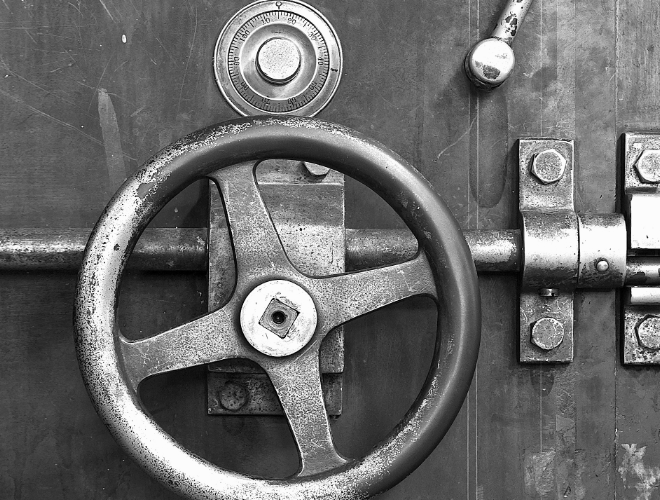
Thomas Lloyd was a local philanthropist who lived in Warwick for 35 years. This pub was a branch of his family’s bank. Numbers 5 and 7 Market Place were acquired by the Warwickshire & Leamington Bank in 1834 and taken over by Lloyds Bank in 1866. The bank acquired number 3 in 1920 and occupied all three until 1998, when they became the Lloyds No.1 bar. Thomas Lloyd lived at the priory 1865–1890. He was a philanthropic man, taking particular interest in the asylum, the gaol and local schools.
Prints and text about churches and chapels
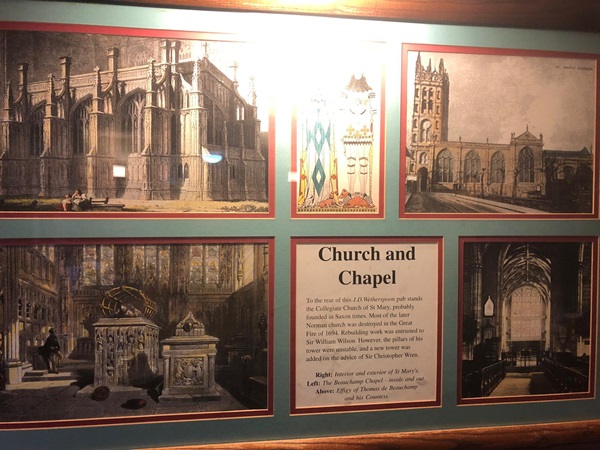
The text reads: To the rear of this J D Wetherspoon pub stands the Collegiate Church of St Mary, probably founded in Saxon times. Most of the later Norman church was destroyed in the Great Fire of 1694. Rebuilding work was entrusted to Sir William Wilson. However, the pillars of his tower were unstable, and a new tower was added on the advice of Sir Christopher wren.
Right: Interior and exterior of St Mary’s
Left: The Beauchamp Chapel – inside and out
Above: Effigy of Thomas de Beauchamp and his countess
Prints and text about literary links
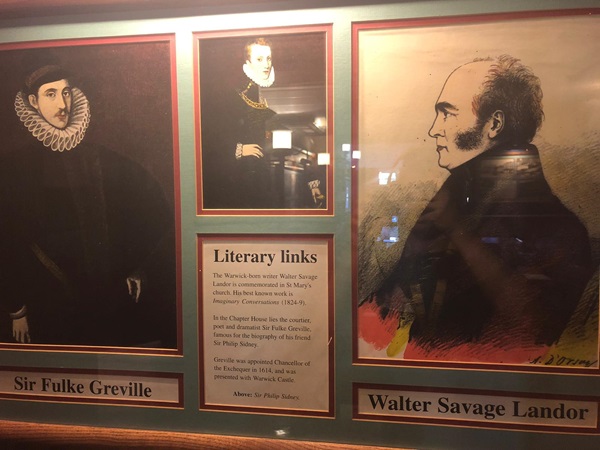
The text reads: The Warwick-born writer Walter Savage Landor is commemorated in St Mary’s Church. His best-known work is Imaginary Conversations (1824–9).
In the Chapter House lies the courtier, poet and dramatist Sir Fulke Greville, famous for the biography of his friend Sir Philip Sidney.
Grevillle was appointed Chancellor of the Exchequer in 1614 and was presented with Warwick Castle.
Prints and text about the Great Fire
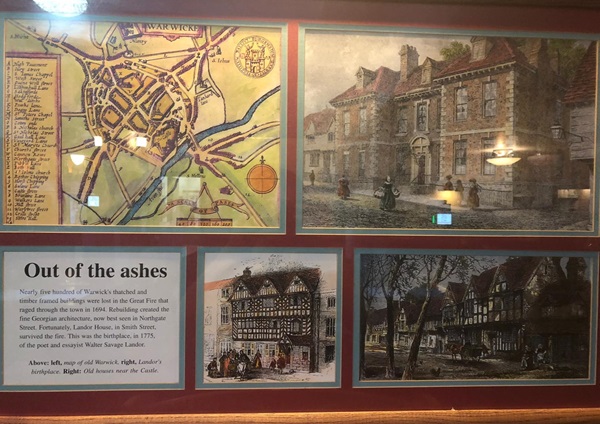
The text reads: Nearly 500 of Warwick’s thatched and timber-framed buildings were lost in the Great Fire that raged through the town in 1694. Rebuilding created the fine Georgian architecture, now best seen in Northgate Street. Fortunately, Landor House, in Smith Street, survived the fire. This was the birthplace, in 1775, of the poet and essayist Walter Savage Landor.
Above, left: Map of old Warwick
Above, right: Landor’s birthplace
Right: Old houses near the Castle
Prints and text about Market Place
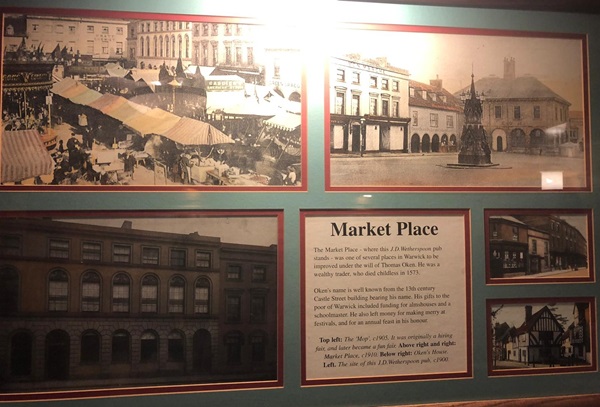
The text reads: The Market Place – where this J D Wetherspoon pub stands – was one of several places in Warwick to be improved under the will of Thomas Oken. He was a wealthy trader, who died childless in 1573.
Oken’s name is well known from the 13th-century Castle Street building bearing his name. His gifts to the poor of Warwick included funding for almshouses and a schoolmaster. He also left money for making merry at festivals, and for an annual feast in his honour.
Prints and text about influential figures
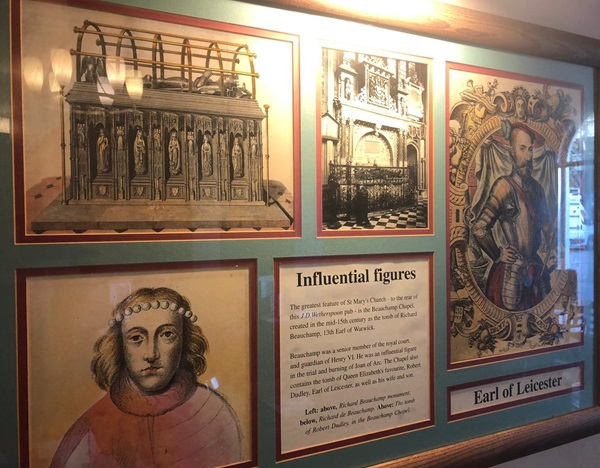
The text reads: The greatest feature of St Mary’s Church – to the rear of this J D Wetherspoon pub – is the Beauchamp Chapel, created in the mid-15th century as the tomb of Richard Beauchamp, 13th Earl of Warwick.
Beauchamp was a senior member of the royal court, and guardian of Henry VI. He was an influential figure in the trial and burning of Joan of Arc. The chapel also contains the tomb of Queen Elizabeth’s favourite, Robert Dudley, Earl of Leicester, as well as his wife and son.
Illustrations and text about the history of Warwick
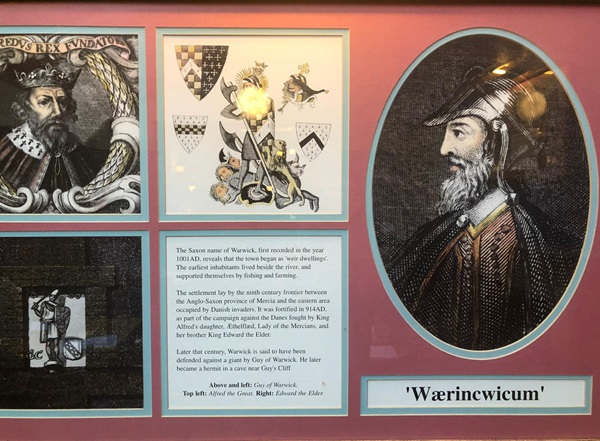
The text reads: The Saxon name of Warwick, first recorded in the year AD 1001, reveals that the town began as ‘weir dwellings’. The earliest inhabitants lived bedside the river and supported themselves by fishing and farming.
The settlement lay by the ninth-century frontier between the Anglo-Saxon province of Mercia and the eastern area occupied by the Danish invaders. It was fortified in AD 914 as part of the campaign against the Danes fought by King Alfred’s daughter, Æthelflaed, Lady of the Mericans, and her brother King Edward the Elder.
Later that century, Warwick is said to have been defended against a giant by Guy of Warwick. He later became a hermit in a cave near Guy’s Cliff.
Above and left: Guy of Warwick
Top, left: Alfred the Great
Right: Edward the Elder




